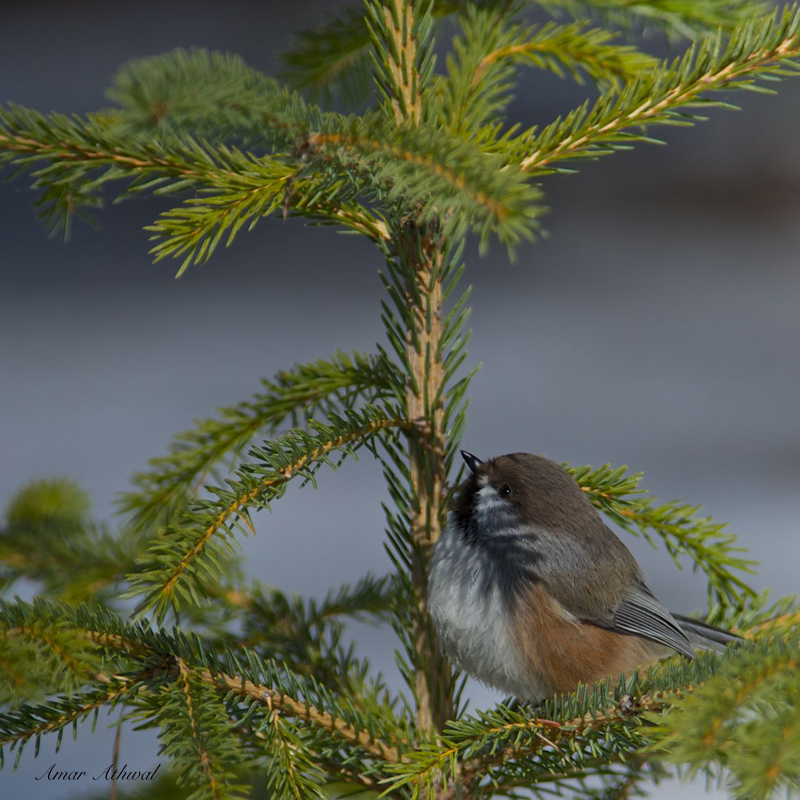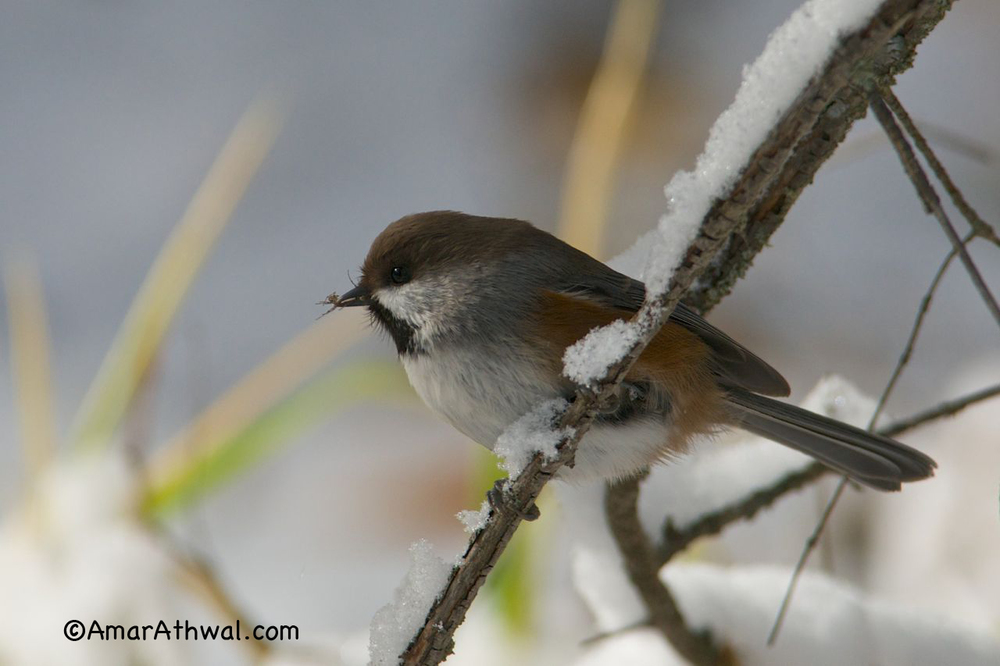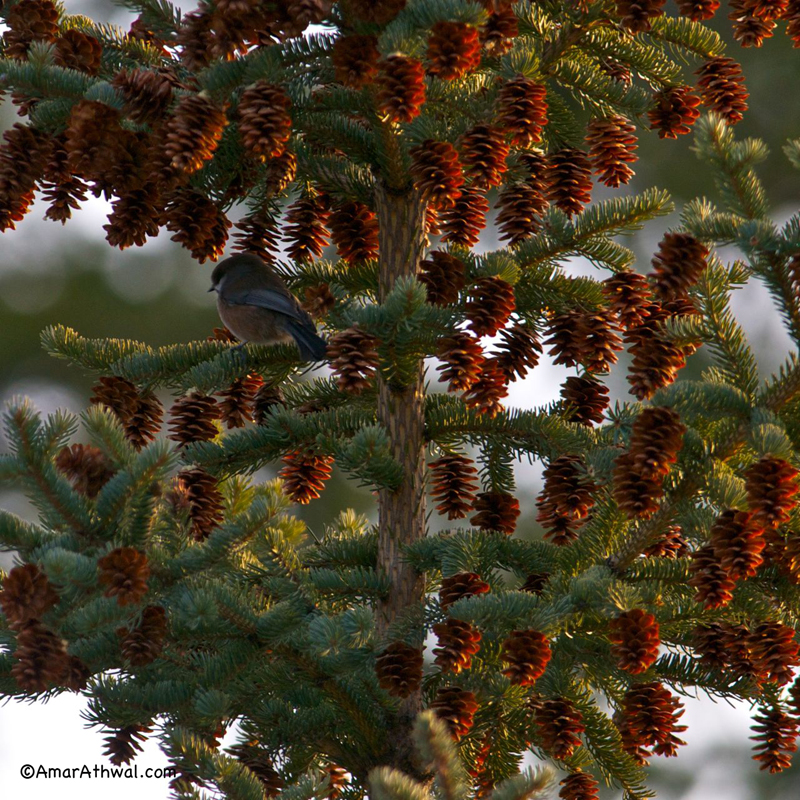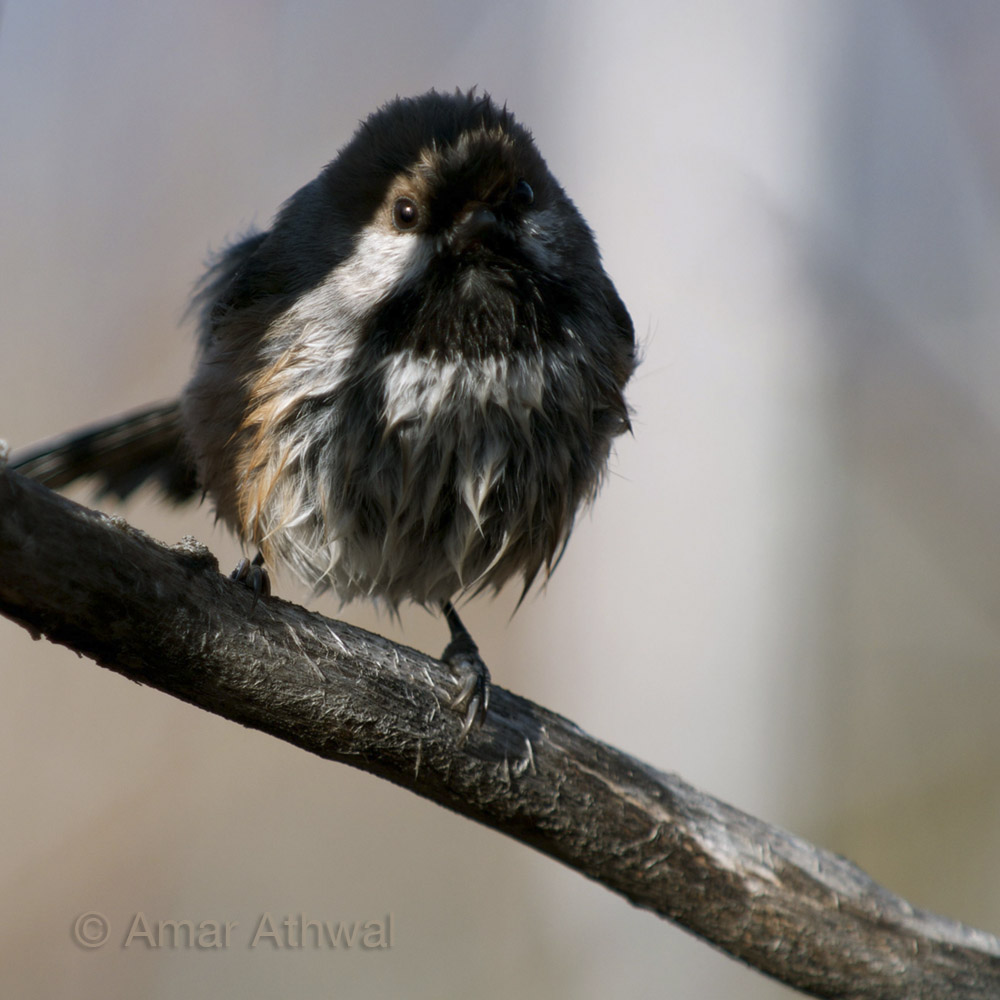The Boreal Chickadee, is a bird that can be spotted all year in the Canadian Rockies. If it does make a move southward, it’s due to a lack of food and not getting away from winter. To stay dry in winter, the chickadees have a preen gland near the base of their tail. They use their beak and feet to spread the oil from the gland all over their feathers to repel water. They flex their pectoral muscles to create heat, which is trapped in fluffed up feathers. Feathers are great insulators. Just ask anyone with a down jacket. Before winter, the chickadees put on heavier plumage. The denser feathers create a more comfortable personal parka for the birds. During deep cold temperatures, the chickadees adapt by lowering their body temperature at night, from 40 degrees Celsius to 29. Helping them conserve body fat. They also cache food, which can be retrieved during the harsh winter months. Not bad for a bird that weighs the equivalent of two sheets of 8.5 x 11 paper.
Boreal Chickadee
On my way back to my car, I had decided to wander through an open area surrounded on both sides by woodland. I was walking or trying to walk without breaking through the snow crust. I stopped when I heard birds, there were over hundred Common Redpolls with few Pine Siskins sprinkled in. Moving slowly toward them, hoping with each step I would not step through the crust and startle them. After getting close enough and started taking their pictures and at the same time I could hear behind me Boreal Chickadees. When I looked back, they were a few feet away. I went back to taking pictures of the redpolls, waiting until the chickadees were little farther away. Then slowly turned completely toward the chickadees and started getting better pictures. As long as I did not make any quick moves, chickadees were fine with me, I slowly moved to get into a better position. They were great models to work with, always within 3 to 4 meters from me, giving me one great pose after another. It was one of those moments when I knew right away I was getting good images, no need to look at the LCD. When they started moving away, I turned around to learn the redpolls were gone. It was time to move on.
Boreal Chickadee
All things being equal, getting a good picture of birds is the hardest part of nature photography for me. No problem getting a picture of a bird, big or small. But to get a good picture of a bird, where it stands out, that’s the challenge. It starts with locating a bird, followed by tracking the bird through the camera, smaller the bird, harder it is to do. Then I try to get close to the bird without scaring it away, for me it works best when I figure out which direction the bird is moving and wait ahead of it and let the bird decide to get close to me. The birds have so many options with each move, always a good chance I’ll not get a clean look. But with nature photography it about staying positive and always thinking this will be the day. There are bird photographer who will use food to get close up pictures. For them, it's all about the picture. With me when shooting wild birds, I’ll always learn something about them and with lots of work and some luck I may get a good image. With bird photography I end up keeping a very small percentage of the images, we’re talking about single digits. One cold day standing in knee deep snow, I was watching several Boreal Chickadees. Waiting and waiting until one got closer and in a position where it stood out. The bird only gave me a couple of seconds to get it in focus and get the whole bird in the frame. No cropping was done with this image. Within 15 to 20 minutes I took about 400 images, kept less than 10. Nature keeps you humble.
Boreal Chackadee

I have taken many pictures of Boreal Chickadees so I was looking for something different. In this case the soft green background while the bird perched on the dead branch of willow was it.
Until next moment,
Amar
Boreal Chickadee

The Boreal Chickadee was spotted on the ground in the middle of the forest. While taking few pictures, it moved away from me, I took few steps toward it.Then it got behind a small spruce tree, I waited. It started moving up the tree, and I kept taking its pictures. When it got front of the tree with sunlight on it , I grabbed the picture
Until next moment,
Amar
Boreal Chickadee

Boreal Chickadees are one of the few birds that spend their winter in the rocky mountains. They are always busy looking for food to help keep them warm. Here is one that's about to eat a itsy bitsy spider.
Until next moment,
Amar
Boreal Chickadee

It was late in the day and I was not sure if I was going to make out the boreal Chickadee in the pictures. But I liked the way the side light hit the cones and went for it. Was able to get out enough details to make out the chickadee while still having the cones looking like part of a Christmas tree decoration.
Until next moment,
Amar
Boreal Chickadee

Light plays a large role as to how the subject will look in a photograph. You only have to look at the mountains with the first or the last light of the day and compare that with middle of the day light. I also find it interesting when on a cloudy day, light breaks through and highlight a subject. Same goes when ray of light breaks through the forest and light up a flower. With birds I most often prefer light coming from behind me and showing all the beautiful colours it hold. But it can be fun when the bird is not fully under the direct light. As in the attached picture, light and lack of makes the Boreal Chickadee look like a 10 gram bully.
Until next moment,
Amar


